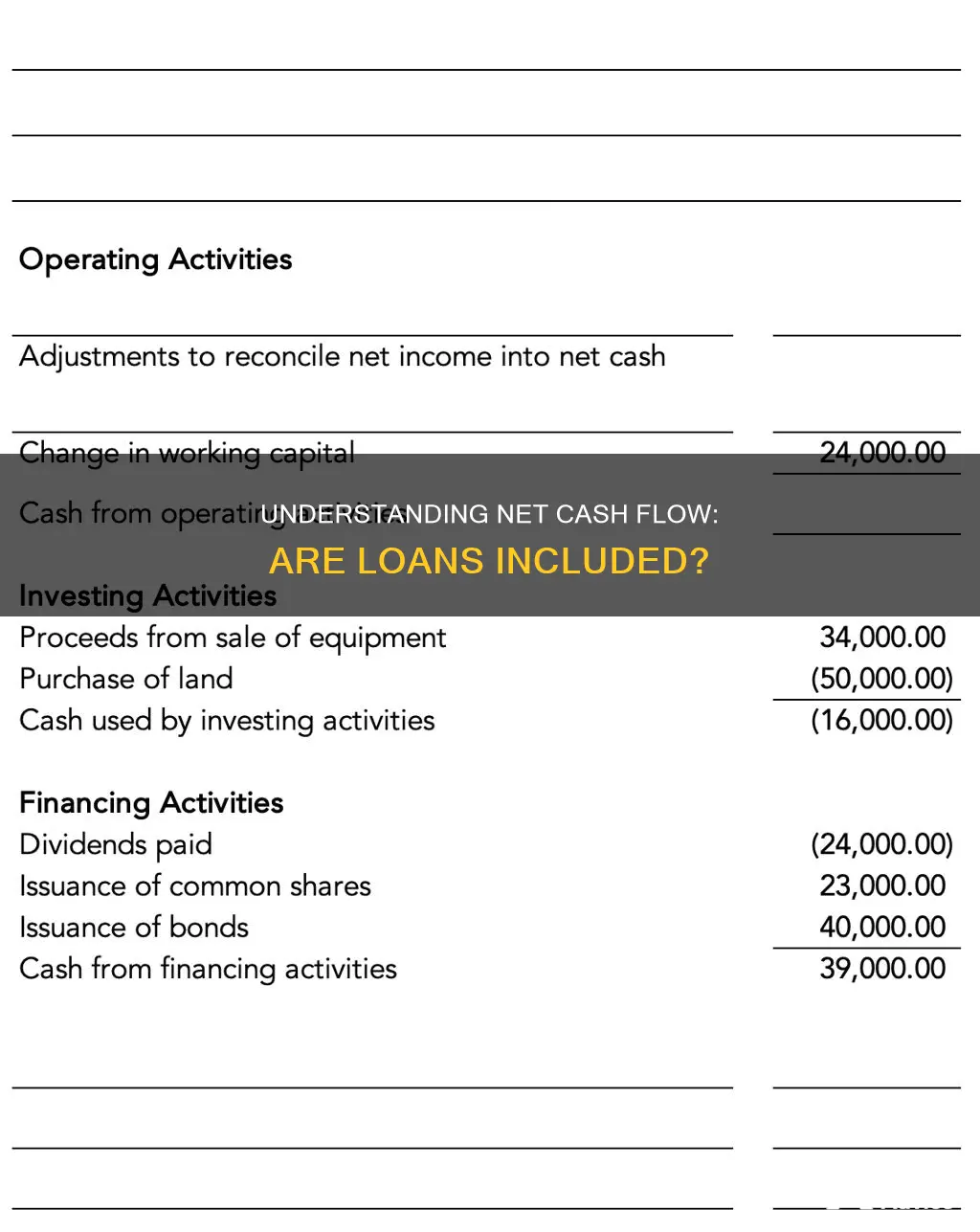
Net cash flow is a financial figure that is calculated by subtracting a company's total cash outflows from its total cash inflows. It is a crucial indicator of a company's financial health and stability, helping businesses cover costs, invest in growth, and manage unexpected expenses. Net cash flow is derived from three main sources: operating activities (sales and day-to-day expenses), investing activities (buying or selling assets), and financing activities (loans, dividends, crowdfunding). This introduction will explore the role of loans in net cash flow calculations and their impact on a company's financial position.
| Characteristics | Values |
|---|---|
| Definition | Net cash flow is the difference between the cash coming in and going out of a business. |
| Calculation | Net cash flow = total cash inflows – total cash outflows |
| Components | Operating activities (sales and day-to-day expenses), investing activities (buying or selling assets), and financing activities (loans, dividends, crowdfunding). |
| Importance | Net cash flow is essential for financial stability as it helps businesses cover costs, invest in growth, and handle unexpected expenses. It is also an indicator of a company's financial health and ability to meet its financial obligations. |
| Positive vs. Negative | A positive cash flow indicates a healthy business with room for growth, while a negative cash flow may signal inefficiencies in working capital and require careful planning. |
| Improvement Strategies | To improve cash flow, businesses can reduce unnecessary expenses, encourage early payments, boost sales, secure financing, and leverage accounting tools for better financial management. |
What You'll Learn

Net cash flow from financing activities
Net cash flow is the difference between the cash coming into and going out of a business. It is a useful metric for financial stability, helping businesses cover costs, invest in growth, and handle unexpected expenses. Net cash flow from financing activities, also known as CFF, is one of the three core sections of a company's cash flow statement. The other two sections are cash flow from investing activities and cash flow from operating activities.
CFF tracks the net change in cash related to financing activities, such as raising capital, borrowing money, and repaying debt. It includes transactions involving the issuance of debt or equity, paying dividends, and distributing earnings to shareholders. CFF provides insights into a company's financial health, growth prospects, and capital structure management. A positive CFF indicates that a company has raised more cash than it has paid out, suggesting growth and expansion. However, relying too much on external financing can lead to high debt burdens. On the other hand, a negative CFF could indicate healthy debt repayment or liquidity concerns.
To calculate CFF, you subtract the outflows from the inflows: CFF = Cash Inflows From Financing - Cash Outflows From Financing. It is important to note that neither a positive nor a negative CFF is inherently good or bad. The interpretation depends on the company's financial strategy and overall business context. CFF has limitations as it provides a short-term view and does not explain the long-term impact of financing decisions. Therefore, investors and analysts need to consider CFF alongside other financial information to assess a company's financial health accurately.
Retirement Savings: Mutual of America's Loan Policy Explained
You may want to see also

Loans as part of cash flow from investing activities
Loans are indeed a part of a company's cash flow, specifically under the category of cash flow from financing activities. This category also includes transactions such as issuing shares, crowdfunding, repaying debt, paying dividends to shareholders, and using business credit cards for expenses.
However, it is important to note that loans can also be classified as cash flow from investing activities, even if they are later reclassified as held for sale. Investing activities include the purchase of physical assets, investments in securities, or the sale of securities or assets. These investments can be made to generate income or as long-term investments in the health and performance of the company.
Negative cash flow from investing activities does not always indicate poor financial health. It often means that the company is investing in assets, research, or other long-term development activities vital to the company's health and continued operations.
The cash flow statement provides an account of the cash used in operations, including working capital, financing, and investing. It is an essential tool for investors to assess a company's financial health and make informed decisions.
Nationwide's Bridging Loan Options: What You Need to Know
You may want to see also

Positive net cash flow
Net cash flow is a profitability metric that represents the amount of money produced or lost by a business during a given period. It is calculated by subtracting total cash outflow from total cash inflow. A positive net cash flow indicates a healthy business with room for growth, while negative cash flow isn't always bad but requires careful planning.
A positive net cash flow means that a company's liquid assets are increasing, enabling it to cover obligations, reinvest in its business, return money to shareholders, pay expenses, and provide a buffer against future financial challenges. It also indicates that the company has retained cash in the business and added to its reserves to handle short-term liabilities and fluctuations in the future.
It is important to note that net cash flow is not the only indicator of a company's financial health, and there are other financial measurements to consider, such as changes in overheads and debt levels. Additionally, while a positive cash flow is generally a good sign, it may not always be beneficial for the business's overall health. For instance, a company with a consistently high positive cash flow may be relying too heavily on external financing, which could lead to high debt burdens in the future. Therefore, it is crucial to consider other financial factors and strategies when evaluating a company's financial health and potential.
MyAutoLoan: Exploring Cosigner Loan Options and Possibilities
You may want to see also

Negative net cash flow
A business can be profitable with negative cash flow, as earning revenue does not necessarily mean that the company has received cash immediately. For instance, a company might accrue profit from selling goods but will not receive the money until a later date based on the payment terms. A negative cash flow can also be the result of operational issues, such as late payments from clients.
Negative cash flow can be harmful to a business's finances, making it difficult to grow and reinvest cash into the business. It is important for small business owners to understand when their cash flow is negative and to be able to manage it effectively.
What Happens to My Student Loans After Death?
You may want to see also

Cash flow statement
A cash flow statement is a financial report that details how cash entered and left a business during a reporting period. It is a part of a company's financial statement that tracks its actual cash movements, providing a clear picture of liquidity and its financial health. It is important for investors, business owners, managers, and stakeholders to understand a company's cash flow statement to make informed decisions and recommendations.
The cash flow statement consists of three main sections: operating activities, investing activities, and financing activities. Operating activities detail the cash flow generated once a company delivers its regular goods or services and includes revenue and expenses. This section shows whether the company can sustain itself without external financing. Positive operating cash flow means a business is generating enough cash to cover expenses, while negative cash flow may signal inefficiencies in working capital.
The investing activities section of the cash flow statement tracks cash movements related to long-term investments that affect a company's growth. Cash inflows come from selling assets, divesting subsidiaries, or collecting loan payments, while cash outflows include capital expenditures, investments in securities, and business acquisitions.
The financing activities section deals with actions such as taking out loans, issuing shares, and crowdfunding efforts. It also covers repaying debt and paying dividends to shareholders. This section helps assess a company's financing strategy and its reliance on external financing. A positive cash flow from financing activities (CFF) indicates growth, while a negative CFF could suggest debt repayment or liquidity concerns. However, it is important to consider the company's entire financial structure when interpreting CFF.
There are two methods for preparing a cash flow statement: the direct method and the indirect method. The direct method involves recording actual cash inflows and outflows from customers, suppliers, and operating expenses. On the other hand, the indirect method starts with net income and makes adjustments to undo the impact of accruals made during the reporting period. Both methods are accepted by Generally Accepted Accounting Principles (GAAP) and International Financial Reporting Standards (IFRS).
NACA Loans: Closing Costs Added or Avoided?
You may want to see also
Frequently asked questions
Net cash flow is the difference between the cash coming into and going out of a business. It is calculated by subtracting total cash outflows from total cash inflows.
Sources of cash inflows include revenue from sales, services, and other income streams. Cash outflows include salaries, rent, utilities, loan repayments, and other operating expenses.
Net cash flow includes cash flows from operating, investing, and financing activities. Operating activities refer to the cash flows from a company's core business operations, including revenue and expenses. Investing activities refer to the purchase or sale of assets, and financing activities refer to loans, dividends, and other funding sources.
Net cash flow is useful for evaluating a company's financial health and stability. It helps determine whether a company is generating enough cash to meet its operating expenses and financial obligations. Positive net cash flow indicates a healthy business, while negative net cash flow may require careful planning and financial management.







